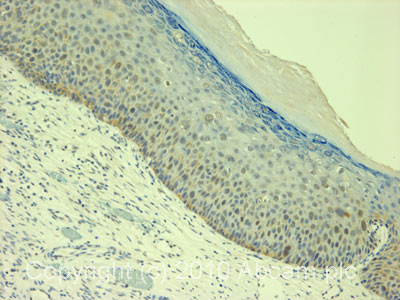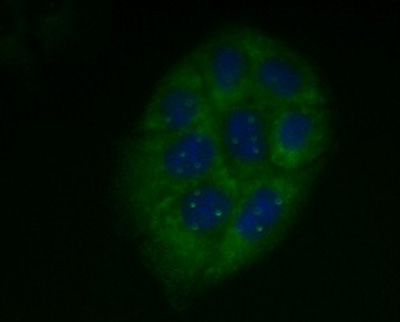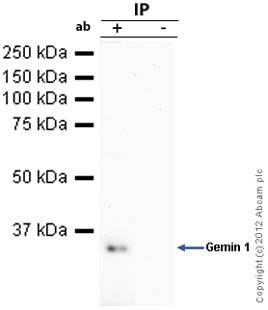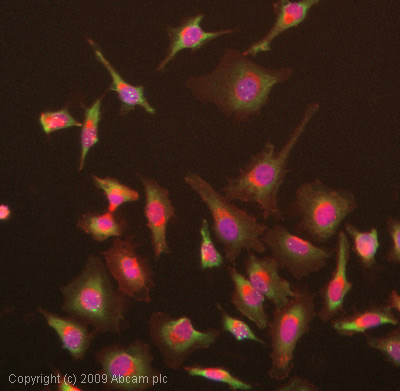![All lanes : Anti-Gemin 1 antibody [2B1] (ab5831) at 1 µg/mlLane 3 : HepG2 (Human hepatocellular liver carcinoma cell line) Whole Cell Lysate Lane 4 : HeLa (Human epithelial carcinoma cell line) Whole Cell LysateLysates/proteins at 10 µg per lane.SecondaryGoat polyclonal to Mouse IgG - H&L - Pre-Adsorbed (HRP) (ab65485) at 1/3000 dilutiondeveloped using the ECL techniquePerformed under reducing conditions.](http://www.bioprodhub.com/system/product_images/ab_products/2/sub_2/23861_Gemin-1-Primary-antibodies-ab5831-5.jpg)
All lanes : Anti-Gemin 1 antibody [2B1] (ab5831) at 1 µg/mlLane 3 : HepG2 (Human hepatocellular liver carcinoma cell line) Whole Cell Lysate Lane 4 : HeLa (Human epithelial carcinoma cell line) Whole Cell LysateLysates/proteins at 10 µg per lane.SecondaryGoat polyclonal to Mouse IgG - H&L - Pre-Adsorbed (HRP) (ab65485) at 1/3000 dilutiondeveloped using the ECL techniquePerformed under reducing conditions.

IHC image of ab5831 staining in human normal cervical carcinoma formalin fixed paraffin embedded tissue section, performed on a Leica BondTM system using the standard protocol F. The section was pre-treated using heat mediated antigen retrieval with sodium citrate buffer (pH6, epitope retrieval solution 1) for 20 mins. The section was then incubated with ab5831, 5µg/ml, for 15 mins at room temperature and detected using an HRP conjugated compact polymer system. DAB was used as the chromogen. The section was then counterstained with haematoxylin and mounted with DPX.For other IHC staining systems (automated and non-automated) customers should optimize variable parameters such as antigen retrieval conditions, primary antibody concentration and antibody incubation times.
![Overlay histogram showing HepG2 cells stained with ab5831 (red line). The cells were fixed with 4% paraformaldehyde (10 min) and then permeabilized with 0.1% PBS-Tween for 20 min. The cells were then incubated in 1x PBS / 10% normal goat serum / 0.3M glycine to block non-specific protein-protein interactions followed by the antibody (ab5831, 1µg/1x106 cells) for 30 min at 22°C. The secondary antibody used was DyLight® 488 goat anti-mouse IgG (H+L) (ab96879) at 1/500 dilution for 30 min at 22°C. Isotype control antibody (black line) was mouse IgG1 [ICIGG1] (ab91353, 2µg/1x106 cells) used under the same conditions. Acquisition of >5,000 events was performed. This antibody gave a positive signal in HepG2 cells fixed with 100% methanol (5 min)/permeabilized in 0.1% PBS-Tween used under the same conditions.](http://www.bioprodhub.com/system/product_images/ab_products/2/sub_2/23863_Gemin-1-Primary-antibodies-ab5831-10.jpg)
Overlay histogram showing HepG2 cells stained with ab5831 (red line). The cells were fixed with 4% paraformaldehyde (10 min) and then permeabilized with 0.1% PBS-Tween for 20 min. The cells were then incubated in 1x PBS / 10% normal goat serum / 0.3M glycine to block non-specific protein-protein interactions followed by the antibody (ab5831, 1µg/1x106 cells) for 30 min at 22°C. The secondary antibody used was DyLight® 488 goat anti-mouse IgG (H+L) (ab96879) at 1/500 dilution for 30 min at 22°C. Isotype control antibody (black line) was mouse IgG1 [ICIGG1] (ab91353, 2µg/1x106 cells) used under the same conditions. Acquisition of >5,000 events was performed. This antibody gave a positive signal in HepG2 cells fixed with 100% methanol (5 min)/permeabilized in 0.1% PBS-Tween used under the same conditions.

ab5831 staining Gemin 1 in human HeLa cells by Immunocytochemistry/ Immunofluorescence. The cells were fixed in methanol and then blocked using 0.2% fish scale gelatin for 1 hour at 25°C. Samples were then incubated with primary antibody at 1/300 for 20 minutes at 25°C. The secondary antibody used was a donkey anti-mouse IgG conjugated to Alexa Fluor® 488 (green) used at a 1/500 dilution. Counterstained with DAPI (blue).Gemin 1 is clearly visible in the cytoplasm and also as small dots in the nucleus (cajal bodies).

Gemin 1 was immunoprecipitated using 0.5mg Hela whole cell extract, 5µg of Mouse monoclonal to Gemin 1 (ab5831) and 50µl of protein G magnetic beads (+). No antibody was added to the control (-). The antibody was incubated under agitation with Protein G beads for 10min,Hela whole cell extract lysate diluted in RIPA buffer was added to each sample and incubated for a further 10min under agitation.Proteins were eluted by addition of 40µl SDS loading buffer and incubated for 10min at 70oC; 10µl of each sample was separated on a SDS PAGE gel, transferred to a nitrocellulose membrane, blocked with 5% BSA and probed with ab5831.Secondary: Goat polyclonal to mouse IgG light chain specific (HRP) at 1/5000 dilution.Band: 32kDa: Gemin 1

ICC/IF image of ab5831 stained HeLa cells. The cells were 4% PFA fixed (10 min) and then incubated in 1%BSA / 10% normal goat serum / 0.3M glycine in 0.1% PBS-Tween for 1h to permeabilise the cells and block non-specific protein-protein interactions. The cells were then incubated with the antibody (ab5831, 1µg/ml) overnight at +4°C. The secondary antibody (green) was Alexa Fluor® 488 goat anti-mouse IgG (H+L) used at a 1/1000 dilution for 1h. Alexa Fluor® 594 WGA was used to label plasma membranes (red) at a 1/200 dilution for 1h. DAPI was used to stain the cell nuclei (blue) at a concentration of 1.43µM.
![All lanes : Anti-Gemin 1 antibody [2B1] (ab5831) at 1 µg/mlLane 3 : HepG2 (Human hepatocellular liver carcinoma cell line) Whole Cell Lysate Lane 4 : HeLa (Human epithelial carcinoma cell line) Whole Cell LysateLysates/proteins at 10 µg per lane.SecondaryGoat polyclonal to Mouse IgG - H&L - Pre-Adsorbed (HRP) (ab65485) at 1/3000 dilutiondeveloped using the ECL techniquePerformed under reducing conditions.](http://www.bioprodhub.com/system/product_images/ab_products/2/sub_2/23861_Gemin-1-Primary-antibodies-ab5831-5.jpg)

![Overlay histogram showing HepG2 cells stained with ab5831 (red line). The cells were fixed with 4% paraformaldehyde (10 min) and then permeabilized with 0.1% PBS-Tween for 20 min. The cells were then incubated in 1x PBS / 10% normal goat serum / 0.3M glycine to block non-specific protein-protein interactions followed by the antibody (ab5831, 1µg/1x106 cells) for 30 min at 22°C. The secondary antibody used was DyLight® 488 goat anti-mouse IgG (H+L) (ab96879) at 1/500 dilution for 30 min at 22°C. Isotype control antibody (black line) was mouse IgG1 [ICIGG1] (ab91353, 2µg/1x106 cells) used under the same conditions. Acquisition of >5,000 events was performed. This antibody gave a positive signal in HepG2 cells fixed with 100% methanol (5 min)/permeabilized in 0.1% PBS-Tween used under the same conditions.](http://www.bioprodhub.com/system/product_images/ab_products/2/sub_2/23863_Gemin-1-Primary-antibodies-ab5831-10.jpg)


